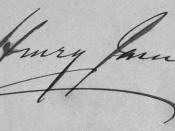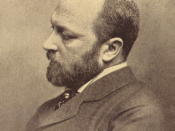'In the case of Henry James there should not be much dispute about the exactness and completeness of the representation; no man ever strove more studiously or on the whole more successfully to reproduce the shape and color and movement of his æsthetic experience.' These are the remarks of Stuart P. Sherman from his article entitled 'The Aesthetic Idealism of Henry James,' from The Nation, p. 397, April 5, 1917. Now, some seventy-two years later critical readers are still coming to terms with James' aesthetic vision. As we have discussed in class, James aestheticizes everything. Sexual intercourse, carnal knowledge, painful self-discovery, human mortality, etc., are often figuratively and metaphorically veiled so as not to disturb or repulse the reader. Taking a closer look at this, one might say that James did this so that he himself would not be repulsed. Perhaps James wasn't thinking so much of the reader as he was thinking of himself.
In 'The Beast in the Jungle' James has aesthetically hidden the reality of Marcher's destiny by treating it as a symbolic crouching beast waiting to spring. The reader will ask why James has done this? Wouldn't it be more effective to speak plainly of Marcher's and Bartram's relationship? The author could tell us exactly why John Marcher does not marry May Bartram. The narrator tells us that Marcher's situation 'was not a condition he could invite a woman to share' and 'that a man of feeling didn't cause himself to be accompanied by a lady on a tiger hunt' (p. 417). This is nonsense. Marcher won't marry May because he doesn't want to inconvenience her with his condition or endanger her life on a tiger hunt? First of all, he inconveniences her right up to the day of her death with his condition,


